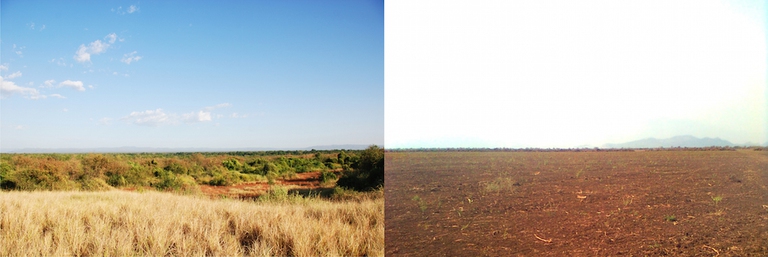
A special report from the Yuqui territory delves deep into the dreams, challenges, joys and sadness of one of Bolivia’s most vulnerable indigenous groups.
Gibe III, now almost complete, is one of Africa’s largest dams. Like its predecessors Gibe I and II it diverts the flow of the Omo River in Ethiopia, which feeds 90% of Lake Turkana in Kenya, the world’s most extensive desert lake. 260,000 indigenous people from 17 ethnic groups live in the Lower Omo Valley,
Gibe III, now almost complete, is one of Africa’s largest dams. Like its predecessors Gibe I and II it diverts the flow of the Omo River in Ethiopia, which feeds 90% of Lake Turkana in Kenya, the world’s most extensive desert lake. 260,000 indigenous people from 17 ethnic groups live in the Lower Omo Valley, the southernmost part of the river, and around Lake Turkana, relying on seasonal floods for their livelihood. The $1.8 billion project threatens their existence by diverting water to the irrigation of 455,000 hectares of monocultures, principally of sugar cane, and the exportation of hydroelectric energy.
No comprehensive Environmental and Social Impact Assessment (ESIA) of the project has ever been conducted and the contract to build the dam was awarded to the Italian company Salini Costruttori non-competitively, thus in violation of Ethiopian law. A programme of systematic forced displacement known as “villagisation” has made space for the commercial plantations irrigated thanks to the dam, supported by the Promotion of Basic Services (PBS) programme financed by the Development Assistance Group (DAG). The latter brings together 26 institutions including the aid agencies of the European Union, United States, United Kingdom and Italy (financed by their citizens’ taxes), and the World Bank.
In March 2016 the NGO Survival International, which works to defend the rights of indigenous peoples worldwide, reported Salini to the Organisation for Economic Cooperation and Development (OECD). According to Survival, the company “did not seek the consent of local people before building the dam, but claimed that an ‘artificial flood release’ would compensate them for their losses. However, this promised flood never came and thousands of people now face starvation”. The NGO’s Director Stephen Curry pointed out that “stealing people’s land and causing massive environmental destruction is not ‘progress’, it is a death sentence for tribal peoples”.
The dam is causing irreversible damage to two UNESCO World Heritage Sites, five national parks and the last pristine riverine forest in desert Africa. The UNESCO World Heritage Site Committee has recommended that Lake Turkana, whose water level could decrease by 22 metres, be put on the List of World Heritage in Danger, which includes sites such as Palmyra in Syria.
The dam is a cultural and social disaster as well as an ecological one. The indigenous peoples of the Lower Omo Valley and Lake Turkana are small-scale farmers, hunter-gatherers and pastoralists. The interruption of the natural cycle of floods of the Omo River and the depletion of Lake Turkana will make it impossible for them to grow food and raise livestock, with neither the Ethiopian nor the Kenyan governments devising any alternatives. Many fear that with no food to eat and nowhere to go these populations will turn to fighting each other in a scramble for survival. In the words of a local government official in Kenya’s Turkana County, “we cannot eat electricity. What we require is food and income”.
Though DAG had already come under fire for supporting a villagisation programme in the Gambela region of Ethiopia, predating Gibe III, because of evidence of human rights violations, the indigenous inhabitants of the Lower Omo Valley and Lake Turkana have also been grossly abused. The Ethiopian military has forcefully evicted, raped, arbitrarily imprisoned and killed many. Furthermore, no free, prior and informed consent (FPIC) on the part of the indigenous communities was sought even though this principle is sanctioned by Article 10 of the UN Declaration on the Rights of Indigenous Peoples.
The damaging effects of dams and the displacement of indigenous populations, often related phenomena, are well known. The Omo River is yet another area of the world that is seeing a systematic destruction of the livelihood and cultures of its peoples and integrity of its natural landscape because of hydroelectricity. Though it’s too late to block Gibe III, rights abuses in the Lower Omo Valley and Lake Turkana must stop, solutions to sustain its indigenous populations must be sought and we must demand that aid agencies cease spending our tax money to finance destructive mega-infrastructure.
Siamo anche su WhatsApp. Segui il canale ufficiale LifeGate per restare aggiornata, aggiornato sulle ultime notizie e sulle nostre attività.
![]()
Quest'opera è distribuita con Licenza Creative Commons Attribuzione - Non commerciale - Non opere derivate 4.0 Internazionale.
A special report from the Yuqui territory delves deep into the dreams, challenges, joys and sadness of one of Bolivia’s most vulnerable indigenous groups.
The Yuqui people of the Bolivian Amazon fight not only to survive in the face of settlers, logging and Covid-19, but to preserve their culture and identity.
Jair Bolsonaro is accused of crimes against humanity for persecuting indigenous Brazilians and destroying the Amazon. We speak to William Bourdon and Charly Salkazanov, the lawyers bringing the case before the ICC.
Activists hail the decision not to hold the 2023 World Anthropology Congress at a controversial Indian school for tribal children as originally planned.
Autumn Peltier is a water defender who began her fight for indigenous Canadians’ right to clean drinking water when she was only eight years old.
The pandemic threatens some of the world’s most endangered indigenous peoples, such as the Great Andamanese of the Andaman and Nicobar Islands in India.
The Upopoy National Ainu Museum has finally opened. With it the indigenous people of Hokkaido are gaining recognition but not access to fundamental rights.
A video shows the violent arrest of indigenous Chief Allan Adam, who was beaten by two Royal Canadian Mounted Police (RCMP) officers.







